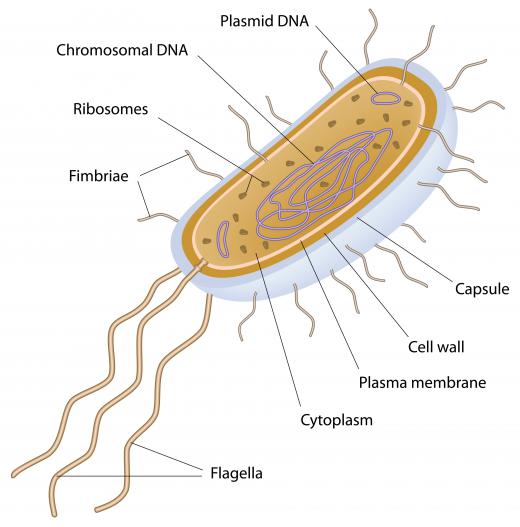What are Methanogens?
 Niki Foster
Niki Foster
Methanogens are a type of microorganism that produces methane as a byproduct of metabolism in conditions of very low oxygen. They are often present in bogs, swamps, and other wetlands, where the methane they produce is known as "marsh gas." Methanogens also exist in the guts of some animals, including cows and humans, where they contribute to the methane content of flatulence. Though they were once classified as Archaebacteria, methanogens are now classified as Archaea, distinct from Bacteria.
Some types of methanogen, including those of the Methanopyrus genus, are extremophiles, organisms that thrive in conditions most living things could not survive in, such as hot springs, hydrothermal vents, hot desert soil, and deep subterranean environments. Others, such as those of the Methanocaldococcus genus, are mesophiles, meaning they thrive best in moderate temperatures. Methanobrevibacter smithii is the prominent methanogen in the human gut, where it helps digest polysaccharides, or complex sugars.

Methanogens are either rod-shaped or spherical. They do not form a monophyletic group, however, meaning that all the methanogens do not consist of a single ancestor and all its descendants. There are over 50 species, all of which belong to the domain Archaea. Methanogens do not require oxygen, and in some cases, cannot even survive in oxygen, though they may be able to tolerate its presence for sustained periods.

Methanogens are a very diverse group. They use a source of carbon, such as carbon dioxide or acetate, to drive their metabolism, called methanogenesis, along with hydrogen as a reducing agent. Therefore, they have the ecological benefit of removing excess hydrogen and carbon from anaerobic environments. A methanogen that metabolizes carbon dioxide is classified as hydrogenotrophic, while those that metabolize acetate are called acetotrophic or aceticlastic.
Methanogens perform an important ecological function by helping to remove carbon dioxide from the environment. They do so at a substantial price, however, since the process of methanogenesis also produces methane, which has a global warming potential 21 times greater than that of carbon dioxide. This effect can fortunately be offset through the use of methane as a biofuel.
AS FEATURED ON:
AS FEATURED ON:












Discussion Comments
Outline similarities in the environments past and present for methanogens.
Can methanogens be massed produced in a lab, stored in a concentrated form and re-introduced into an anaerobic digester to speed up or enhance production of methane?
Post your comments